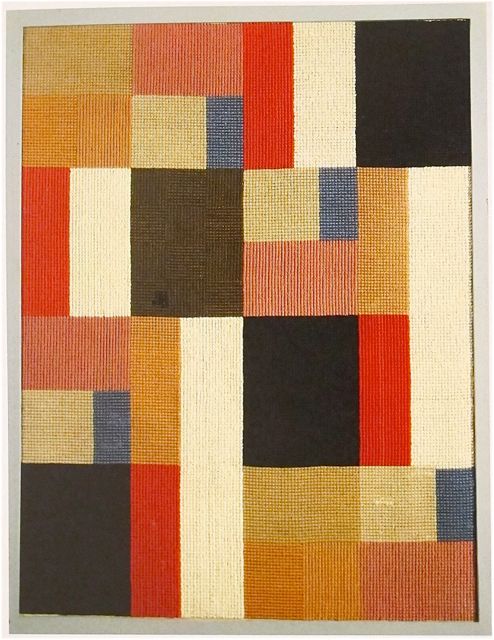^ Sophie Taeuber-Arp, Vertical-Horizontal Composition (1916)
The playful interdisciplinary work by Susanne Nørregård Nielsen responds to Sophie Taeuber-Arp’s (1889-1943) text ‘Remarks on Instruction in Ornamental Design’ (1922) to form the foundation for a series of drawings on paper.
This body of work was exhibited as part of Glasgow International in 2018 and was part of Nielsen’s ARP Research Fellowship 2018,
Stiftung Hans Arp und Sophie Taeuber-Arp e.V. in Berlin.
Pencil to Paper: Notes and Responses to Sophie Taeuber-Arp’s Instructions
Sophie Taeuber-Arp embraced an interdisciplinary practice: embroidery, weaving, tapestry, dance, drawing, painting sculpture, interior design and architecture. The applied artwork by Sophie Taeuber-Arp is less known but now, nearly a century on, is getting attention. Understanding the connections between textile design and the development of abstract art is highly influenced by gender politics and the hierarchical value system of art work versus applied work [1]
‘Composition verticale-horizontale’ [2], a geometric composition in embroidery from 1916, was the first textile work by Sophie Taeuber-Arp I came across. It features a systematic use of motifs and mirrored motifs within a rectangular tile structure of stepped repeats. The choice of the colour yarn is well balanced in tone and contrast. The use of subtle diagonal stitches or Xs makes the yarn reflect the light in different directions. Sophie Taeuber-Arp uses the grid, the inherent properties of the woven structure, in a playful and animated way. Her deep knowledge of textile, its method and materials, helps her to make a clear leap into the development of concrete art. [3]
Sophie Taeuber-Arp studied applied arts at the progressive Debschitz School in Munich and at the School of Arts and Crafts in Hamburg from 1910 to 1914 [4]. She returns to Switzerland and establishes herself as artisan and takes up a post in 1916 as teacher in design and embroidery at the Trade School Zurich, Department for Applied Arts. During this time, she publishes two texts. The first text ‘Remarks on Instruction in Ornamental Design’ is published in Korrespondenzblatt des Schweiz. Vereins der Gewerbe- und Hauswirtschaftslehrerinnen [5] in 1922. The second text ‘Guidelines for Drawing Instruction in the Textile Professions’ is published by Trade School Zurich, co-edited with her colleague Blanche Gauchart in 1927. In this period, she takes dance lessons at the newly established School of Expressive Dance run by Rudolf von Laban. She meets Hans Arp, her future husband, and becomes part of the Dadaist circles.
Some years back I came across a reference to ‘Remarks on Instruction in Ornamental Design’ in Walburga Krupp’s essay ‘>>Try, try…!<<, Variations of a >true artist<’ [6] and decided to see if I could get hold of it.
I contacted the Stiftung Arp e.V. in Berlin and got a copy of the text which I subsequently got translated into English.
As an artist I am interested in the knowledge we can gain from working with methods and materials. Through carrying out the instructions, could I get a better understanding of Sophie Taeuber-Arp’s work? I was just as curious to find out what would I produce: what would the pattern look like?

In the text ‘Remarks on Instruction in Ornamental Design’ Sophie Taeuber-Arp sets out to discuss why it is important to make new designs before giving ‘instruction for independent work’; eight instructions for developing pattern and eight colour excises. I followed each instruction as closely as possible and embraced the possibilities as they emerged.
